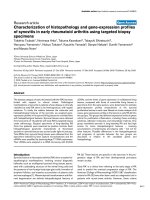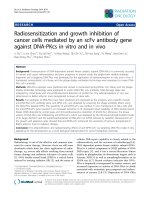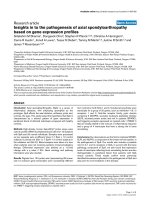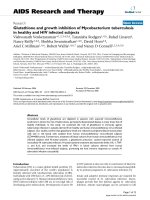Growth inhibition of spodoptera frugiperda larvae by camptothecin correlates with alteration of the structures and gene expression profiles of the midgut
Bạn đang xem bản rút gọn của tài liệu. Xem và tải ngay bản đầy đủ của tài liệu tại đây (1.38 MB, 7 trang )
Shu et al. BMC Genomics
(2021) 22:391
/>
RESEARCH ARTICLE
Open Access
Growth inhibition of Spodoptera frugiperda
larvae by camptothecin correlates with
alteration of the structures and gene
expression profiles of the midgut
Benshui Shu, Yan Zou, Haikuo Yu, Wanying Zhang, Xiangli Li, Liang Cao and Jintian Lin*
Abstract
Background: Spodoptera frugiperda is a serious pest that causes devastating losses to many major crops, including
corn, rice, sugarcane, and peanut. Camptothecin (CPT) is a bioactive secondary metabolite of the woody plant
Camptotheca acuminata, which has shown high toxicity to various pests. However, the effect of CPT against S.
frugiperda remains unknown.
Results: In this study, bioassays have been conducted on the growth inhibition of CPT on S. frugiperda larvae.
Histological and cytological changes were examined in the midgut of larvae fed on an artificial diet supplemented
with 1.0 and 5.0 µg/g CPT. The potential molecular mechanism was explored by comparative transcriptomic
analyses among midgut samples obtained from larvae under different treatments. A total of 915 and 3560
differentially expressed genes (DEGs) were identified from samples treated with 1.0 and 5.0 µg/g CPT, respectively.
Among the identified genes were those encoding detoxification-related proteins and components of peritrophic
membrane such as mucins and cuticle proteins. Kyoto Encyclopedia of Genes and Genomes (KEGG) pathway
enrichment analyses indicated that part of DEGs were involved in DNA replication, digestion, immunity, endocrine
system, and metabolism.
Conclusions: Our results provide useful information on the molecular basis for the impact of CPT on S. frugiperda
and for future studies on potential practical application.
Keywords: Spodoptera frugiperda, Camptothecin Adverse effects, Transcriptome analysis
Background
The fall armyworm, Spodoptera frugiperda (Lepidoptera:
Noctuidae), is an important insect pest worldwide. The
insect can feed on at least 353 plant species including
major crops such as corn, rice, soybeans, sugar cane, and
cotton [1–3]. S. frugiperda is native to tropical and subtropical regions of the Americas, but has been spread to
* Correspondence:
Guangzhou City Key Laboratory of Subtropical Fruit Trees Outbreak Control,
Institute for Management of Invasive Alien Species, Zhongkai University of
Agriculture and Engineering, 313 Yingdong teaching building, 510225
Guangzhou, PR China
Africa and Asia in recent years [4]. The voracious caterpillar was first found in 2019 in Yunnan Province, China.
Since then it has spread rapidly to most parts of the
country [5]. Previous studies have been focused on finding control strategies such as various monitoring
methods, correct identification of species and strains by
genotyping, biological control and chemical application
[5]. Effective insecticides for controlling S. frugiperda include pyrethroids, diacyl hydrazides, diamides, and benzoylureas [6]. Extensive application of insecticides
caused problems including arise of populations with
© The Author(s). 2021 Open Access This article is licensed under a Creative Commons Attribution 4.0 International License,
which permits use, sharing, adaptation, distribution and reproduction in any medium or format, as long as you give
appropriate credit to the original author(s) and the source, provide a link to the Creative Commons licence, and indicate if
changes were made. The images or other third party material in this article are included in the article's Creative Commons
licence, unless indicated otherwise in a credit line to the material. If material is not included in the article's Creative Commons
licence and your intended use is not permitted by statutory regulation or exceeds the permitted use, you will need to obtain
permission directly from the copyright holder. To view a copy of this licence, visit />The Creative Commons Public Domain Dedication waiver ( applies to the
data made available in this article, unless otherwise stated in a credit line to the data.
Shu et al. BMC Genomics
(2021) 22:391
resistance to insecticides, toxicity to beneficial animals,
and harmful effects on human health.
Plants are considered the most abundant natural resource in the world for the identification of chemicals
with insecticidal activity [7, 8]. Plant secondary metabolites protect plants from herbivores and are potential
candidates for novel insecticides [9]. In fact, many existing insecticides are derivatives of plant metabolites. For
example, pyrethrum and nicotine are used as botanical
pesticides for pest control for decades [10]. In recent
years, the effect of plant secondary metabolites against S.
frugiperda has been investigated. For example, the botanical insecticide azadirachtin is very toxic to S. frugiperda,
with LC50 values 0.59 and 0.46 mg/L for 2nd and 3rd instar larvae, respectively, under 0.3 % azadirachtin emulsifiable concentrate (EC) [11]. Cedrelone, a metabolite
isolated from the Australian red cedar Toona ciliata, is
toxic to S. frugiperda larvae as well [12]. The flavonoid
rutin extracted from soybean prolongs the development of
S. frugiperda larvae, causing reduced larval and pupal viability [13]. The toxicity of extracts from Actinostemon concolor, Piper aduncum, and Ruta graveolens has also been
tested against S. frugiperda caterpillars [14–16].
Camptothecin (CPT), a pentacyclic quinoline alkaloid
isolated from the plant Camptotheca acuminata Decne,
is a potent pharmaceutical secondary metabolite with
antitumor activities in mammalian cells by targeting
intracellular DNA topoisomerase I, resulting in inhibition of nucleic acid synthesis and induction of DNA
strand breakage [17, 18]. CPT has also displayed insecticidal activity against several insects, including Drosophila
melanogaster, Musca domestica, Mythimna separata,
and Spodoptera exigua [10, 19, 20]. Field tests with 0.2 %
camptothecin emulsifiable concentrate (EC) have shown
high mortality on three important agricultural pests
Nilaparvata lugens (Ståhl) Brevicoryne brassicae (L.),
and Chilo suppressalis (Walker) [21]. Due to its low
water solubility properties, a series of CPT derivatives
have been developed through structural modification
[22]. Phytophagous mites including Tetranychus urticae,
Acaphylla theae and Brevipalpus obovatus were sensitive
to the aqueous CPT-Na+ solution under laboratory and
field conditions [23]. The toxicity mechanism indicated
that CPT inhibits DNA topoisomerase I (topo I) [10].
Besides, CPT up-regulated the expression of programmed cell death protein 11 in Spodoptera litura,
which could be involved in apoptosis induction [24].
While the effects of CPT against S. frugiperda and relevant molecular mechanisms remain to be revealed.
The objective of this study is to investigate the adverse
effect of CPT against S. frugiperda. Changes in the weight
of S. frugiperda larvae were examined after treatments
with different CPT concentrations. Histopathological and
ultrastructural changes in the midgut of larvae fed on diets
Page 2 of 13
containing 1.0 and 5.0 µg/g CPT, respectively, were examined. In addition, comparative transcriptomic analyses
were carried out with different midgut samples from larvae under different treatments. Our results indicated that
CPT is a growth inhibitor of S. frugiperda larvae and has
the potential as an insecticide for controlling this important insect pest in the field.
Results
CPT inhibits S. frugiperda larval growth
To examine any adverse effect of CPT against S. frugiperda, third-instar larvae were fed on artificial diets containing 0, 1.0, 2.5, 5.0, 10, 20, and 30 µg/g CPT,
respectively. The weight of larvae for each sample was
recorded on 1, 3, 5, and 7 days after treatments. The
average weight of larvae fed on CPT-diets for one day
showed no significant difference compared with that of
controls. Weight loss was observed in larvae fed on CPT
diets for 3, 5, and 7 days (Fig. 1). Our results indicated
that CPT inhibited the growth of S. frugiperda larvae in
a dose-dependent manner.
CPT causes structural damages in S. frugiperda larval
midgut
After 7 days of feeding, the larvae from the control
group developed to sixth instar larvae, while the larvae
treated with CPT grew slowly, and developed only into
fourth or fifth instars. Histopathological changes were
observed in the larval midgut fed on diets containing 1.0
and 5.0 µg/g CPT for 7 days based on hematoxylin-eosin
(HE) staining. As shown in Fig. 2 A, midgut cells were
tightly arranged in multiple layers with a thick intestinal
wall in control insects. In comparison, many cells were
disappeared and only a thin intestinal barrier was observed in the larval midgut fed on a 1.0 µg/g CPT diet
(Fig. 2B). The severity of damage to the gut was dosedependent. In larvae fed on a diet containing 5.0 µg/g
CPT, only the basement membrane was left in the intestinal wall of the midgut, and nearly all functional cells
disappeared (Fig. 2 C). Similar phenomena were observed in the gut structure under TEM. In control larvae, chromatin was evenly distributed in the nucleus.
Mitochondria and endoplasmic reticulum were abundant and distributed evenly in the cytoplasm. Microvilli
were ordinally distributed in the gut (Fig. 2D). In contrast, the number of mitochondria and endoplasmic
reticulum decreased in midgut cells in larvae treated
with 1.0 µg/g CPT. Microvilli were disorganized (Fig. 2E).
In larvae fed on the 5.0 µg/g CPT diet, chromatin condensation occurred and chromatins were located close
to the nuclear envelope. Microvilli decreased and deformed with large cavities (Fig. 2 F). Our results
Shu et al. BMC Genomics
(2021) 22:391
Page 3 of 13
Fig. 1 The growth inhibitory effects of CPT under different concentrations on S. frugiperda larvae. Average weight of individual larva was
presented as mean ± SEM (n = 60). The larvae fed on the artificial diet was used as CK. Treatments were larvae fed on the diet supplemented with
different concentrations of CPT. Different capital letters indicate significant differences (p < 0.01) between different doses as determined using
ANOVA followed by DMRT
indicated that CPT had negative effects on the midgut
structure of S. frugiperda larvae.
Transcriptomic analyses
Midguts dissected from larvae treated with CPT (1.0 and
5.0 µg/g) for 7 days and control larvae were used for transcriptomic analyses. The number of raw reads from nine
libraries ranged from 43,911,148 to 51,395,872. High quality reads ranged from 43,587,740 to 51,021,846 (Supplement Table 1). Q20 and Q30 refer to the percentage of
bases with sequencing quality above 99 and 99.9 % to the
total bases in the transcriptome. Values of Q20 and Q30
in each transcriptome were more than 98 and 96 %, respectively (Supplement Table 1). A total of 58,122 unigenes was obtained from the de novo assembling of all
combined reads. The length of the unigenes ranged from
201 to 28,483 bp, with an average of 765.28 bp. N50 and
GC content of the unigenes were 1358 bp and 40.55 %, respectively. Original data were deposited to the SRA database with the accession number of SRP242660.
Transcripts assembled by Trinity were submitted to the
TSA database with the accession number SUB8976341.
Functional annotation of unigenes
Unigenes were annotated by blasting six common databases, including NCBI non-redundant protein sequences
(NR), Swiss-Prot, Protein family (Pfam), Cluster of
Orthologous Groups of proteins (COG), Gene Ontology
(GO), and KEGG. A total of 26,461 (45.53 %) unigenes
were functionally annotated. The number of unigenes
matched to NCBI NR, COG, GO, Pfam, Swiss-Prot, and
KEGG databases were 24,937 (42.90 %), 22,844 (39.30 %),
18,265 (31.43 %), 16,888 (29.06 %), 16,335 (28.10 %), and
14,110 (24.28 %), respectively (Supplement Figure 1 A).
Based on BLAST results against the NR database, most
(16,697 or 66.9 %) of annotated S. frugiperda unigenes
shared the highest similarity (first hit) to sequences from
S. litura, followed by Helicoverpa armigera (1447 unigenes, 5.80 %), Trichoplusia ni (764 unigenes, 3.06 %),
Heliothis virescens (720 unigenes, 2.89 %), Eumeta japonica (388 unigenes, 1.56 %), and C. suppressalis (347 unigenes, 1.39 %) (Supplement Figure 1B). Only 303
unigenes (1.22 %) showed the highest similarity to sequences from S. frugiperda, suggesting that this important pest has been understudied genomically.
The 16,888 annotated unigenes were divided into three
categories: biological process, cellular component, and
molecular function. The GO terms of binding, catalytic
activity, and cellular process were with the most numbers of unigenes, with 9310, 8554, and 6308 in each category, respectively (Supplement Figure 1 C). The
unigenes with KEGG annotations could be classified into
five major categories, including Metabolism (3182
Shu et al. BMC Genomics
(2021) 22:391
Page 4 of 13
Fig. 2 Histopathological and ultrastructural changes in the midgut of larvae fed on the diet supplemented with 1.0 and 5.0 µg/g CPT. A:
Hematoxylin–eosin staining of the midgut obtained from larvae fed on a normal diet. B: Histopathological changes in the midgut dissected from
larvae fed on the diet supplemented with 1.0 µg/g CPT. C: Histopathological changes of the midgut dissected from larvae fed on the diet
supplemented with 5.0 µg/g CPT. D: The ultrastructure of the midgut obtained from larvae fed on normal diet. E: The ultrastructure of the midgut
dissected from larvae fed on the diet supplemented with 1.0 µg/g CPT. F: The ultrastructure of the midgut dissected from larvae fed on the diet
supplemented with 5.0 µg/g CPT. Me: midgut epithelium, Bm: basement membrane, L: lumen. N: nuclei, M: mitochondria, ER: endoplasmic
reticulum, MV: microvilli, V: vacuole, FD: fat droplet
unigenes), Genetic Information Processing (2507 unigenes),
Environmental Information Processing (1889 unigenes), Cellular Processes (1987 unigenes), and Organismal Systems
(2663 unigenes) (Supplement Figure 1D). For the secondary
categories, the pathways of signal transduction, translation,
and carbohydrate metabolism were ranked as the top three
subcategories, with 1681, 1200, and 1079 unigenes, respectively, in each subcategory.
Identification of DEGs based on transcriptomes
A total of 915 unigenes were expressed differentially between controls and samples treated with 1.0 µg/g CPT.
Compared to the control group, 612 unigenes were upregulated and 291 unigenes were down-regulated in the
group treated with 1.0 µg/g CPT (Fig. 3 A). The number
of DEGs between control and 5.0 µg/g CPT-treated samples increased to 3560. Among the DEGs, 2201 were upregulated and 1359 down-regulated (Fig. 3 A). Comparative analyses revealed that 683 unigenes were differentially expressed in both 1.0 and 5.0 µg/g CPT-treated
samples when compared to control. Among the common DEGs, 464 were up-regulated and 217 downregulated (Fig. 3B and C).
A large number of DEGs were genes involved in detoxification, including genes encoding cytochrome P450
monooxygenases (P450s), glutathione S-transferases
(GSTs), carboxylesterases (COEs), UDP glucosyltransferases (UGTs), and ATP-binding cassette transporters
(ABCs). As shown in Table 1 and 39 detoxification genes
were differentially expressed between controls and samples treated with 1.0 µg/g CPT. These differentially
expressed genes encode 20 P450s, 3 GSTs, 6 COEs, 7
UGTs, and 3 ABCs. Most of these DEGs were upregulated, including 15 coding for P450s, 5 for COEs,
and 5 for UGTs (Table 1). The number of detoxification
genes expressed differentially between controls and samples treated with 5.0 µg/g CPT increased to 108, including genes encoding 57 P450s, 13 GSTs, 8 COEs, 11
UGTs, and 19 ABCs. Among the up-regulated DEGs, 23
were genes coding for P450s, 1 for GST, 2 for COEs, 4
for UGTs, and 11 for ABCs (Table 1).
In addition to DEGs with functions in detoxification,
several genes encoding mucins were also expressed differentially among control and treated samples. Mucins
are high molecular weight glycoproteins covering the
surface of epithelial cells that respond to external environmental stimuli such as infection, dehydration, and
physical and chemical injury [25]. Two and 18 genes encoding mucins were differentially expressed between
controls and samples treated with 1.0 and 5.0 µg/g CPT,
respectively. The unigenes encoding mucin-5AC
Shu et al. BMC Genomics
(2021) 22:391
Page 5 of 13
(DN34507_c0_g1) and mucin-17 (DN3811_c0_g1) were
up-regulated in samples treated with 1.0 µg/g CPT when
compared to control. Most (16) DEGs encoding mucin
proteins were up-regulated in samples treated with
5.0 µg/g CPT, and only two mucin genes were downregulated (Fig. 4 A).
The third major group of DEGs included genes encoding cuticle proteins (CPs), which are indispensable structural components for insect tissues such as cuticle and
midgut peritrophic membrane. Specifically, Four genes
encoding larval cuticle protein LCP-17 (DN2495_c0_g1),
cuticle protein 6.4-like (DN2113_c0_g1), cuticle protein
CP14.6-like (DN38621_c0_g1) and cuticular protein RR2 (DN1220_c0_g1) were down-regulated in samples
treated with 1.0 µg/g CPT. Interestingly, 26 unigenes encoding cuticle proteins were up-regulated in samples
treated with 5.0 µg/g CPT, whereas there were only two
cuticle protein-encoding genes that were downregulated (Fig. 4B).
GO and KEGG analyses
Fig. 3 A venn diagram of DEGs obtained from different
comparative analyses. A: A venn diagram of total DEGs obtained
from different comparative analyses. There were 683 unigenes that
exhibited differential expression between samples treated with 1.0
and 5.0 µg/g CPT. B: A venn diagram of up-regulated DEGs obtained
from different comparative analyses. There were 464 unigenes that
exhibited up-regulated expressions in samples treated with 1.0 and
5.0 µg/g CPT when compared to control. C: A venn diagram of
down-regulated DEGs obtained from different comparative analyses.
There were 217 unigenes that exhibited down-regulated expressions
in samples treated with 1.0 and 5.0 µg/g CPT when compared to
control. Purple ring represents DEGs identified from the comparison
between controls and samples treated with 1.0 µg/g CPT. Green
ring represents DEGs identified from the comparison between
controls and samples treated with 5.0 µg/g CPT
A total of 553 DEGs between controls and samples
treated with 1.0 µg/g CPT were assigned to 175 GO
terms. Among these GO terms, 30 were enriched significantly (corrected P-values < 0.05). The enriched GO
terms for biological process included “carbohydrate derivative metabolic process”, “aminoglycan metabolic
process”, “chitin metabolic process”, “glucosamine-containing compound metabolic process”, and “amino sugar
metabolic process”. The enriched GO terms for cell
component included “membrance part”, “integral component of membrane” and “intrinsic component of
membrane”. The enriched GO terms for molecular function included “oxidoreductase activity”, “transporter activity”, and “transmembrane transporter activity”
(Supplement Figure 2 A).
A total of 2000 DEGs between controls and samples
treated with 5.0 µg/g CPT were assigned to 215 GO
terms. Among these GO terms, 43 were enriched significantly (corrected P-values < 0.05). The most significantly
enriched GO term for biological process was “chitin
metabolic process” (corrected P-value = 7.27901E-08, 50
DEGs). The most significantly enriched GO term for cellular component was “extracellular region” (corrected Pvalue = 8.61215E-08, 107 DEGs). The most significantly
enriched GO term for molecular function was “structural constituent of cuticle” (corrected P-value =
7.27901E-08, 35 DEGs) (Supplement Figure 2B).
KEGG analysis revealed that 369 DEGs between controls and samples treated with 1.0 µg/g CPT were
assigned to 178 pathways. Among the 178 pathways, five
were enriched significantly (corrected P-values < 0.05),
including “DNA replication” (15 DEGs), “Purine
(2021) 22:391
Shu et al. BMC Genomics
Page 6 of 13
Table 1 The statistics of detoxification related unigenes with differentially expression in different midgut samples
Treatment
Detoxification related genes
Number of DEGs
Up-regulated
Down-regulated
CPT-1 μg/g
P450s
20
15
5
GSTs
3
0
3
COEs
6
5
1
UGTs
7
5
2
ABCs
3
0
3
Total
39
25
14
P450s
57
23
34
GSTs
13
1
12
COEs
8
2
6
UGTs
11
4
7
ABCs
19
11
8
Total
108
41
67
CPT-5 μg/g
metabolism” (15 DEGs), and “Ribosome biogenesis in eukaryotes” (14 DEGs). KEGG analysis assigned 1401 DEGs
between controls and samples treated with 5.0 µg/g CPT
to 232 pathways. The most significantly enriched pathways included “Purine metabolism” (42 DEGs), “Ribosome
biogenesis in eukaryotes” (41 DEGs), and “Peroxisome”
(36 DEGs) (Fig. 5 C and 5D). “DNA replication” was the
most significantly enriched KEGG pathway in both samples treated with either 1.0 or 5.0 µg/g CPT.
qRT-PCR validation
To confirm the results of transcriptomic analyses, 20
unigenes including genes involved in detoxification and
DNA replication, genes encoding mucins and cuticle
proteins genes, were selected for qRT-PCR validation.
As shown in Fig. 6, the expression patterns of the selected genes in S. frugiperda midguts changed significantly after CPT treatments based on qRT-PCR analysis.
The changes in gene expression levels based on qRTPCR were largely consistent with the transcriptomic
data.
Discussion
S. frugiperda has become a serious insect pest in China
in the past couple of years [26]. Various chemicals such
as chlorantraniliprole, spinetoram, emamectin benzoate,
spinetoram, acephate, and pyraquinil have been evaluated to control this pest in the field [27–29]. Some bioactive compounds including azadirachtin isolated from
Azadirachta indica and celangulins extracted from the
Fig. 4 Heatmaps of selected DEGs in response to CPT treatments. A: The heatmap of differentially expressed unigenes encoding mucins after CPT
treatments. B: The heatmap of differentially expressed unigenes coding for cuticle proteins
Shu et al. BMC Genomics
(2021) 22:391
Page 7 of 13
Fig. 5 KEGG pathway analyses of identified DEGs. A: The top 14 pathways enriched with DEGs obtained from midgut samples from larvae treated
with 1.0 µg/g CPT with FDR values. Among them, five pathways were significantly enriched with corrected P-values < 0.05. B: The 14 pathways
significantly enriched with DEGs obtained from midgut samples from larvae treated with 5.0 µg/g CPT (corrected P-values < 0.05). The x-axis
represents rich factor
medicinal plant Celastrus angulatus have been studied
for potential control of this destructive insect [11, 30].
CPT is a natural indole alkaloid used for cancer therapy
[31]. The insecticidal activity of CPT against other insect
pests has also been investigated. In this study, development delay was induced in S. frugiperda larvae treated
with CPT, but no mortality was observed. This result
may be due to the high number of detoxifying enzyme
genes that are often in polyphagous pests [32]. In
addition, synergism between CPT and Bacillus thuringiensis (Bt) or nucleopolyhedroviruses exists against Trichoplusia ni and S. exigua [33]. Our results showed that
CPT can inhibit the growth of S. frugiperda larvae.
Therefore, CPT might be used as an independent insecticide for controlling S. frugiperda. Alternatively, CPT
may be used with other insecticides for enhanced efficiency. One limitation of CPT as an insecticide is its insolubility in water. More efficient derivatives with
improved solubility and hydrophobicity may be developed in the future for pest control.
The insect midgut is an important organ responsible
for food digestion and nutrient absorption [34, 35]. CPT
has been reported to induce alterations in the midguts
of Trichoplusia ni and S. exigua larvae, including the loss
of the single layer of epithelial cells and the disruption of
the peritrophic membrane [33]. In this study, we observed the loss of epithelial cells, abnormal cell structure,
and intestinal wall degradation in the midgut of S. frugiperda after CPT treatments. These observations are consistent with previous findings in other insects, suggesting
that CPT holds the potential as an insecticide for controlling S. frugiperda and other insect pests.
Recently, transcriptomic analysis has become a routine
method to identify the differentially expressed genes in
insects in response to toxic compounds [36]. For example, transcriptomic analyses have been carried out to
identify DEGs in the Chinese populations of S. frugiperda in response to 23 pesticides [37, 38]. DEGs in S.
frugiperda larvae treated with azadirachtin were also initially analyzed [36]. In this study, DEGs in S. frugiperda
larvae treated with CPT were analyzed for the first time.
Our transcriptomic analyses of midguts from S. frugiperda larvae revealed that the expression levels of a large
number of genes were affected by CPT treatments.
Among the up-regulated genes by CPT are genes involved in detoxification. Metabolic detoxification
through the overexpression of metabolic genes is considered one of the main ways to handle toxic insecticides
by pests [39]. The insect midgut is an important tissue
responsible for pesticide detoxification where a variety of
detoxification enzymes are produced [40]. Insect midgut
often increases the expression of metabolic genes in response to pesticide treatments. For example, the transcription levels of detoxifying-related genes including
P450s and GSTs were up-regulated by low-dose of acetamiprid in the midgut of B. mori [40]. Sublethal concentrations of Cry1Ca protein altered the expressions of
P450s, CarEs, and GSTs in S. exigua larval midgut [41].
Detoxification-related genes including those encoding
P450s, GSTs, and COEs are up-regulated in S. litura larval midguts after being treated with tomatine [42]. The
roles of several detoxification genes in pesticide resistance in insects have been validated by RNA interference,
including CYP321A8, CYP321A9, and CYP321B1 in S.









